Buhera is one of the seven districts constituting Manicaland Province in eastern Zimbabwe. The district is primarily rural, relying on subsistence agriculture and mining for livelihoods.
Despite challenges such as low rainfall and land degradation, Buhera holds cultural and historical significance within Zimbabwe.
This comprehensive biography delves into various aspects of Buhera, including its history, geographical location, culture, and notable developments.
ALSO READ: https://zimprofiles.com/mysteries-and-marvels-unraveling-the-tapestry-of-nyanga/
Origin of the Name
The name Buhera comes from the Shona language and specifically refers to the Hera, a sub-tribe of the Manyika people who traditionally inhabited the area. Here’s a breakdown of its origin:

Get To Know Buhera: picture credit to Flickr
- Origin: Nguninised version of uHera
- Meaning: Territory of the Hera
- Historical context: Reflects the presence of the Hera people in the area
Here’s some additional information:
- The Ngunini language heavily influenced the Manyika dialect spoken in Buhera, hence the “Nguninised” part of the name.
- Further Anglicisation led to the final form, Buhera.
- The Museyamwa totem associated with the Hera people continues to hold significance in the Buhera District.
History of the Place
Buhera’s History: From Ancient Tribes to Modern District
Buhera’s history stretches back far, intertwined with the story of the Shona people and their sub-tribes. Here’s a glimpse into the different eras:
Early Inhabitants:
- The name “uHera”, meaning “territory of the Hera,” itself reflects the presence of the Hera, a sub-tribe of the Manyika people, during early times. Archaeological evidence suggests settlements dating back to the late Stone Age.
- Unfortunately, documented history is scarce for the period between the Stone Age and the 13th century AD.
Rise of Great Zimbabwe:
- Around the 13th century, the area likely fell under the influence of the Great Zimbabwe state system, evidenced by the presence of several Zimbabwes (stone enclosures) in Buhera. These suggest the area’s importance as a tributary state.
Colonial Era:
- In the late 19th century, European colonization saw British settlers’ arrival and Southern Rhodesia’s establishment. Buhera experienced land dispossession and forced relocations, impacting traditional ways of life.
- From the 1920s to 1950s, Buhera received Ndebele families displaced from other regions, adding to the area’s cultural diversity.
Post-Independence:
- After Zimbabwe’s independence in 1980, Buhera became a rural district facing ongoing challenges like drought, limited infrastructure, and economic hardship.
- Despite these struggles, the community strives for development and preserves its rich cultural heritage.
Additional points of interest:
- The Museyamwa totem remains significant in Buhera, reflecting the historical presence of the Hera people.
- Several historical sites offer glimpses into the past, including Zimbabwes, rock paintings, and colonial-era structures.
Further exploration:
- Wikipedia: https://en.wikipedia.org/wiki/Buhera_District: https://en.wikipedia.org/wiki/Buhera_District
Tribes Around Buhera
The primary tribe in Buhera is the VaHera, under Chief Nyashanu, with the Museyamwa totem.
The Hera claim descent from Guruuswa, north of the Zambezi River.
Various chieftainships and headmen oversee land administration and dispute resolution within the tribe.
Buhera is primarily home to the VaHera, a sub-tribe of the Manyika people, who have resided in the territory for centuries. Their presence is reflected in the very name “Buhera,” which translates to “territory of the Hera” in the Shona language.
However, due to historical migrations and interactions, Buhera’s cultural landscape is more diverse than just the VaHera. Here’s a brief overview of the tribes you might encounter in Buhera:
1. VaHera:
- Totem: Museyamwa (monkey)
- Language: ChiManyika (a dialect of Shona)
- History: Believed to have migrated from Guruuswa, north of the Zambezi River, centuries ago. They form the majority population in Buhera.
2. Ndebele:
- Totem: Various totems depending on family lineage
- Language: isiNdebele
- History: Arrived in Buhera in the 1920s and 1950s, displaced from other regions due to colonial land policies. They form a significant minority community.
3. Smaller communities:
- VaVhenda: Primarily resides in the eastern parts of Buhera, migrating from South Africa in the 19th century.
- VaSotho: Smaller groups descended from Sotho people who integrated with the Ndebele community.
It’s important to remember that tribal identities are complex and fluid, and these categories shouldn’t be seen as rigid boxes.
Intermarriage and cultural exchange have occurred over time, shaping the rich tapestry of Buhera’s society.
ALSO READ: https://zimprofiles.com/ndau-culture-the-heartbeat-of-chimanimani/
Geographical Location
Situated in southeastern Zimbabwe, Buhera District shares borders with several other districts and provinces.
The Save River forms the eastern boundary, while the Devure River and its tributary, the Nyazvidzi, delineate the western boundary.
Key urban settlements include Buhera (the district capital), Murambinda town, Birchenough Bridge, and Dorowa mine.
Buhera is located in the southeastern part of Zimbabwe, within the Manicaland Province. Here’s a breakdown of its geographical location:
- Country: Zimbabwe
- Province: Manicaland Province
- District: Buhera District
- Coordinates: Approximately 19°45′S 31°20′E (see image below)
- Bordering districts:
- Chikomba District and Wedza District (Mashonaland East Province) to the north
- Mutare District to the east
- Chimanimani District and Chipinge District to the southeast
- Gutu District (Masvingo Province) to the south and west
Additional details:
- Buhera is situated in a predominantly rural area, characterized by rolling hills, savanna grasslands, and some mountainous terrain.
- The Save River forms the district’s southern boundary, while the Odzi River flows through the eastern part.
- Buhera experiences a subtropical climate with hot summers and mild winters. Rainfall is seasonal, with most precipitation occurring during the summer months (November to March).
Culture

Get To Know Buhera : picture credit to Flickr
Buhera boasts a rich cultural heritage, with annual ceremonies, traditional practices, and historical landmarks.
Ceremonies such as Mitoro are held annually, often presided over by traditional leaders. The district’s cultural landscape reflects a blend of indigenous traditions and colonial influences.
The culture of Buhera is rich and diverse, shaped by various influences over centuries. Here’s a glimpse into some key aspects:
Traditional Practices:
Subsistence agriculture: The majority of the population relies on farming, mainly maize, sorghum, and millet. Traditional methods like intercropping and terracing are often used.
Craftsmanship: Basket weaving is a renowned skill, particularly using “ilala” palm. Wood carving, pottery, and metalwork are also practised.
Music and dance: Mbira music, using a thumb piano, is central to celebrations and ceremonies. Traditional dances like Jerusarema and Mhande reflect the cultural identity and community spirit.
Spirituality: Traditional beliefs, honouring ancestors and seeking guidance from “vadzimu” (spirits), coexist with Christianity and other religions.
Contemporary Influences:
- Education: While access varies, schools and churches contribute to modernization and exposure to diverse ideas.
- Urban migration: Young people sometimes move to cities for work, bringing back influences and remittances that reshape Buhera’s social fabric.
- Technology: Mobile phones and radio connect residents to wider Zimbabwe and the world, impacting communication and information flow.
Community Values:
- Respect for elders: Age and experience are highly valued, with elders playing key roles in decision-making and cultural transmission.
- Ubuntu/Hunhu: The philosophy of interconnectedness and humanity emphasizes cooperation, hospitality, and social responsibility.
- Resilience: Despite challenges like drought and economic hardship, the community demonstrates strong adaptation and perseverance.
Important to remember:
- This is just a brief overview, and Buhera’s culture is multifaceted and constantly evolving.
- Cultural practices and expressions vary among different communities and families within the district.
- Respecting local customs and traditions is crucial when visiting or interacting with people in Buhera.
Further exploration:
- National Museums and Monuments of Zimbabwe: [<invalid URL removed>]
- The Chronicle: [https://www.chronicle.co.zw/]
- Academic journals and articles: Explore specific aspects of Buhera’s culture through academic research.
ALSO READ: https://zimprofiles.com/bikita-s-cultural-mosaic-history-heritage-and-rural-development/
Places to Visit
Buhera features several noteworthy attractions, including Chiurwi Mountain, Maremare (the highest mountain in the district), and historical sites associated with pre-colonial communities and liberation struggles.
Buhera, nestled in the southeastern folds of Zimbabwe’s Manicaland Province, offers a unique blend of natural beauty, historical intrigue, and vibrant culture.
While it may not be on the typical tourist map, its hidden gems can leave you with unforgettable experiences.
Here are some suggestions for places to visit in Buhera, categorized based on your interests:
History & Culture:
Matendera Ruins: Step back in time at these captivating stone enclosures, reminiscent of Great Zimbabwe, and immerse yourself in the mysteries of the 16th-17th century civilization that thrived here.
Kagumbudzi Muchuchu and Chironga, Chiwona and Gombe Ruins: Explore a cluster of lesser-known ruins scattered across Buhera, each offering unique architectural features and hinting at the area’s rich historical tapestry.
Rock Paintings: Embark on a journey of discovery amidst ancient rock art scattered in various locations, offering glimpses into the lives and beliefs of the region’s early inhabitants.
Nature & Adventure:
Save River: Hike or bike along the scenic banks of the mighty Save River, teeming with diverse birdlife and offering breathtaking views of the surrounding landscape.
Chilo Gorge: Challenge yourself with a trek through the dramatic Chilo Gorge, carved by the Save River, and be rewarded with stunning vistas and a sense of accomplishment.
Dam Fishing: Cast your line in the well-stocked Marovanyati Dam or Tugwi-Mukosi Dam, home to various fish species like bream, bass, and tigerfish, for a relaxing and potentially rewarding experience.
Culture & Community:
Village Homestays: Immerse yourself in the warmth of rural life by staying in a traditional village homestay, experiencing local customs, and cuisine, and participating in daily activities.
Craft Workshops: Witness the skilful hands of local artisans creating intricate baskets, wood carvings, and pottery, and perhaps even try your hand at these age-old crafts.
Traditional Ceremonies: If fortunate enough to be invited, attending a traditional ceremony like a wedding or spirit appeasement ritual offers a profound insight into the community’s cultural values and practices.
Additional Points:
- Remember that responsible tourism is crucial. Be respectful of local customs and traditions, dress modestly, and avoid littering.
- Engage with the community – ask questions, learn about their lives, and support local businesses and initiatives.
- Accommodation options in Buhera are limited, so plan your trip accordingly and consider camping or homestays for a more immersive experience.
By venturing beyond the usual tourist destinations and exploring the hidden gems of Buhera, you’ll discover a place where history comes alive, nature inspires, and culture warms the heart.
Schools in Buhera
Buhera District hosts various educational institutions, from primary to secondary schools, providing access to formal education for residents.
Educational Landscape in Buhera: Primary & Secondary Schools
Buhera boasts a vast network of educational institutions catering to primary and secondary education. Here’s a breakdown, along with resources for further exploration:
Primary Schools:
- Number: As of 2004, Buhera had a staggering 140 primary schools. However, the exact current number might differ slightly.
- Distribution: Schools are spread across the district, ensuring accessibility for most communities.
- Resources: You can find an extensive list of primary schools with their respective addresses in a PDF document hosted by the Ministry of Primary and Secondary Education (MoPSE): <invalid URL removed>: <invalid URL removed>
Secondary Schools:
- Number: In 2004, the district had 55 secondary schools. Again, the current number might vary slightly.
- Types: These include government-run, mission-run, and community-run institutions.
- Resources: Similar to primary schools, a list of secondary schools with their addresses is available in the MoPSE document:
Additional Information:
- Quality: Educational quality varies across schools, with some facing resource limitations and infrastructure challenges.
- Choosing a School: If you seek specific information about a particular school, like enrollment procedures or academic performance, I recommend contacting the school directly or searching online using the school’s name and location.
- Private Schools: While limited, Buhera also has a few private schools offering alternative educational options. You can find their details through online searches or local inquiries.
Remember:
- This information provides a general overview. Educational needs and preferences differ, so thorough research is crucial before making any decisions.
- The MoPSE might offer additional updates and resources.
ALSO READ: https://zimprofiles.com/get-to-know-honde-valley-beautiful-places-to-visit/
Council Contacts
For inquiries and administrative matters related to Buhera District, individuals can contact the district offices located in Buhera settlement.
- Address: Murambinda, Zimbabwe.
- Phone number: +263 21 2284.
- Fax number: +263 21 2287.
References
- “Buhera District.” Wikipedia, Wikimedia Foundation, 2024, en.wikipedia.org/wiki/Buhera_District.
- “Zimbabwe: Buhera.” Africa AHEAD, 2024, africaahead.org/zimbabwe-buhera/.
- “Buhera Tribes Explored – Who Are They?” ZimTribes Blog, 2024, www.blog.zimtribes.com/buhera-tribes-explored-who-are-they/.



